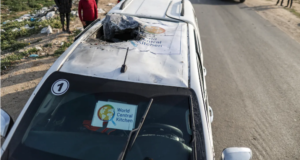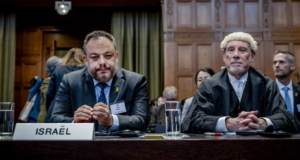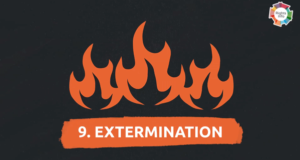Eva Bartlett | In Gaza
2 February 2009
Abdul Rahman Ghraben’s mother carried in a yellow plastic bag. “This is his pant leg, and tiny pieces of him,” she said, holding the knotted bag at the handles. Her husband had been explaining how fourteen year old Abed was killed on January 11.
“The Israeli forces had been bombing hard so we’d evacuated the house, gone to Fakoura (UN school which had been bombed with white phosphorous). The first 3 days at the school we had only the clothes we were wearing, no blankets, no food. At night in Fakoura it was so cold and windy, so when we heard on the radio that there would be a cease-fire between 8 am and 11 am, Abed asked if he could return home to grab a jacket. We all went with him,” Abu Abed explained, now holding the yellow bag.
- Abed’s pants
- Abdul (Abed) Rahman Ghraben
- remains of Abed
- Abu Abed mourns his dead son
- shrapnel
- flower in a bullet hole
“When we were in the house, the Israeli army starting bombing in the area,” said Umm Abed. “We were very frightened, we had thought the cease-fire meant we could return home safely. We quickly took whatever clothes and food we could and left the house. I thought Abed was ahead of us. At the school friends told us Abed hadn’t come back. They also said that a drone had fired a missile at our area. People were saying the missile had hit a child and shattered him to pieces. We didn’t know it was Abed.”
Umm Abed stopped her recollection to take out the contents of the yellow supermarket bag. “We searched for Abed for 2 days. People were telling us ‘your son was killed’ but we couldn’t find his body, we couldn’t believe it had been Abed.”
“Finally,” Abu Abed continued, pulling the tattered pant leg out of the bag, “we found this and knew Abed had been killed. It’s all that was left of him. Since then, since we’ve returned home we find more pieces of him.” The father pulled out a tuft of hair, a dried piece of some internal part of Abed, an inch long piece of sharp shrapnel from the drone’s missile. “Daily we find small bits of him, all over the area. He was blown to bits,” his father says. Although the strike happened 3 weeks ago, the family’s pain is no less fresh.
“Why are they doing this to our children? What did my son do? Did he launch rockets? Where is their humanity when they kill a child like this? He was a child, he had the right to live like any other child,” asked Abu Abed, voicing the questions that parents of over 400 children in Gaza are asking of the Israeli army and Israeli authorities making the decisions to bombard Gaza.
In a bullet hole in the wall beside Umm Abed, a decorative flower had been stuck, the hole too large for the plastic stem. Efforts fall short to cover the ugly rampage of the soldiers inside a house which has been torn apart much as their lives have been torn apart. The Ghraben’s house is in the Hayid Amal neighbourhood of Attatra, in the Beit Lahia region. Like the surrounding houses, it is puckered with scars of Israeli army firing, and bears evidence of the Israeli army’s invasion and rampage through it. A bedroom door is torn off its hinges, clothes shredded by automatic gunfire, damage throughout the house. Abu Yusef, an uncle and neighbour, had the day before shown his house: more extensive trashing had been done, but the family was back living in it, drafts and all.
Abu Abed made a parting plea to those outside Gaza: “We are asking the international community to cut their relationship with Israel, because Israel is killing children. During just 10 minutes in my neighbourhood alone Israeli soldiers killed 10 children,” he said as an example to the wider massacre of children, and adult civilians, which happened during the 3 weeks of war on Gaza. “We are still not safe. We still expect an Israeli bulldozer or tank could enter and bulldoze our homes at any time, because they have before. There are still F-16s which fly over our house, and we never know when the next bomb will be dropped.”
 International Solidarity Movement Nonviolence. Justice. Freedom.
International Solidarity Movement Nonviolence. Justice. Freedom.








